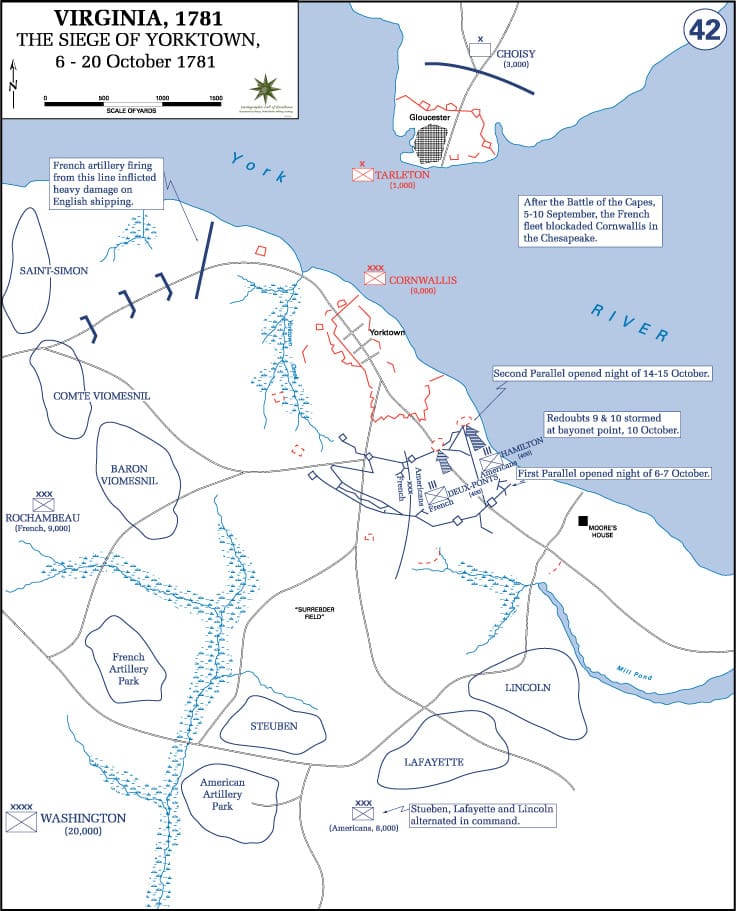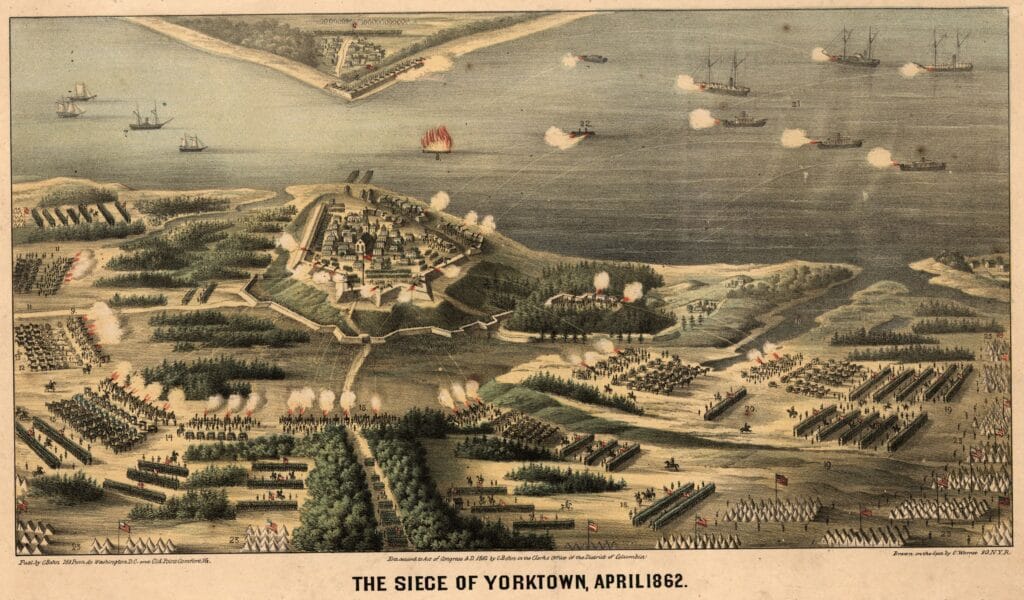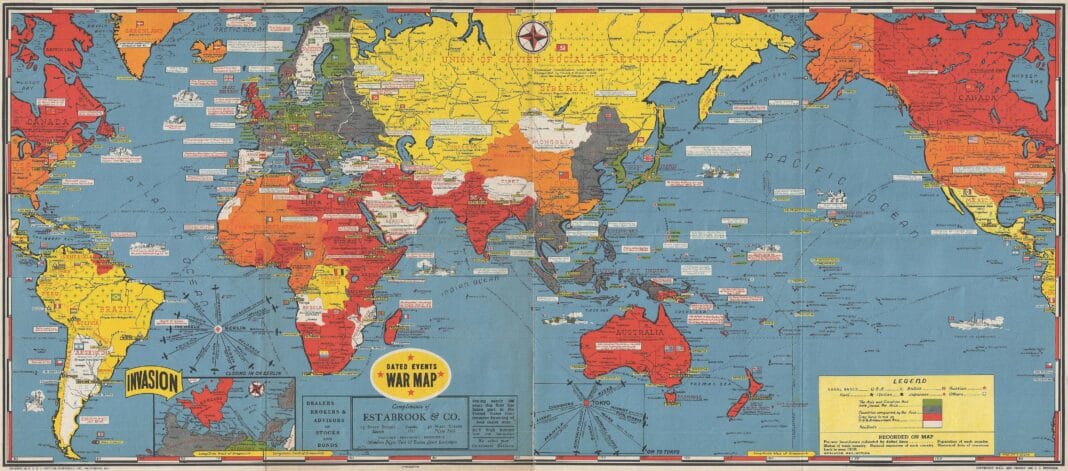The Battle of Yorktown
Discover the significance of The Battle of Yorktown, the decisive victory that ended the American Revolution. Explore its impact, key figures, and lasting legacy.
1.1 – Why the Battle of Yorktown Changed the Course of the American Revolution
Discover how the Battle of Yorktown became the turning point of the American Revolution, sealing a decisive victory that shaped the future of the United States.
The Battle of Yorktown, fought from September 28 to October 19, 1781, marked a decisive turning point in the American Revolutionary War. This battle culminated in the surrender of British General Cornwallis, signaling the end of major hostilities and paving the way for American independence. Located in Virginia, Yorktown became the focal point of a coordinated effort by American and French forces against the British, demonstrating the power of alliance and strategy in warfare.
Those interested in the Battle of Yorktown often seek insights into its historical context, key figures, strategies, and lasting consequences. A comprehensive narrative not only describes the events but also conveys the emotions and stakes involved, providing a deeper understanding of this pivotal moment in American history.
A quote from General George Washington reflects the spirit of the battle: “The world is in the habit of judging events by their immediate consequences, while it is a much more natural and proper method to form an opinion of them from their final results.” “This perspective highlights the crucial role of the triumph at Yorktown, which paved the way for the Treaty of Paris and secured formal recognition of American independence.”

1.2 – Historical context of the Battle of Yorktown in the American Revolutionary War
Discover the historical context of the Battle of Yorktown, the decisive clash of the American Revolutionary War that secured U.S. independence in 1781.
Understanding the Battle of Yorktown requires exploring the historical context of the American Revolutionary War. Tensions had been rising in the years before the battle, as the American colonies grew increasingly dissatisfied with British rule. Events like the Stamp Act of 1765 and the Boston Tea Party of 1773 fueled desires for independence and self-governance among the colonists.
1.2.1 – How early American battles led to the Battle of Yorktown
By 1775, the colonies were prepared to challenge British authority, which led to early battles such as those at Lexington and Concord. The Continental Army, under General George Washington, faced challenges including limited resources and training. However, with crucial support from France following the Treaty of Alliance in 1778, the tide of war began to shift. The French Navy and troops played a significant role in the upcoming conflict at Yorktown.
1.2.2 – Why the British targeted the Southern colonies before Yorktown
The British focused on the Southern colonies as the war continued, expecting stronger loyalty there. However, Washington devised a strategy that involved both French and American forces. By 1781, the British had established a stronghold in Yorktown, Virginia, believing it was secure for resupply and reinforcements.
1.2.3 – General Cornwallis and Washington’s leadership at the Battle of Yorktown
Key figures emerged during this period, such as General Cornwallis, who led the British forces, and Washington, who coordinated the Allied troops. French General Marquis de Lafayette also played a pivotal role, applying his European military expertise and providing vital support.
1.2.4 – How Washington’s siege strategy led to Cornwallis’s surrender
The Siege of Yorktown began on September 28, 1781, and lasted for weeks of intense fighting. Washington’s strategy involved surrounding the British on land while the French Navy blockaded the Chesapeake Bay, preventing Cornwallis from escaping or receiving reinforcements. This strategy led to Cornwallis’s surrender on October 19, 1781, effectively ending major military operations in the war.
1.2.5 – How the Battle of Yorktown influenced the American Revolution’s outcome
The victory at Yorktown was a critical turning point in the fight for American independence. As Washington famously said, “Victory belongs to the most persevering.” The aftermath of the Battle of Yorktown led to peace talks and the eventual recognition of American independence with the signing of the Treaty of Paris in 1783.
1.2.6 – Famous quotes from the Battle of Yorktown
1.2.6.1 – Washington’s famous quote from the Battle of Yorktown
“We must take up arms against our enemies.”
1.2.6.2 – Thomas Jefferson’s views on Liberty and the Battle of Yorktown
“The tree of liberty must be refreshed from time to time with the blood of patriots and tyrants.”
1.2.6.3 – Cornwallis’s feigned illness at the Battle of Yorktown
An anecdote from the battle recounts how Cornwallis, realizing his predicament, attempted to feign illness to avoid confronting Washington, underscoring the psychological strain of the siege.
1.3 – Who Were the Key Figures in The Battle of Yorktown?
Discover the key figures of the Battle of Yorktown, including George Washington and Lord Cornwallis, and learn how their leadership shaped this pivotal Revolutionary War victory.
The Battle of Yorktown was a critical military engagement and the culmination of leadership, strategy, and alliance. Understanding the key figures involved offers insight into how their decisions shaped the outcome of the American Revolutionary War, ultimately leading to the American victory in October 1781.
1.3.1 – How George Washington Led The Battle of Yorktown
As commander-in-chief of the Continental Army, George Washington was central to the victory at Yorktown. His leadership, strategic foresight, and resilience were essential in rallying troops and forging alliances. George Washington understood that achieving victory depended on working closely with French forces and showcasing his talent for international cooperation. His powerful declaration, “We will make them feel the strength of our forces!” reflected both his unwavering resolve and his gift for motivating those under his command.
1.3.2 – How Marquis de Lafayette Helped Secure Victory at Yorktown
Marquis de Lafayette, a French aristocrat and military officer, was a dedicated ally of Washington. He led troops effectively and provided crucial intelligence on British movements. At Yorktown, Lafayette commanded a mix of American and French soldiers, contributing to the encirclement of British forces. His proactive approach to warfare and diplomacy was captured in his quote: “The future will be determined by what we do today.”
1.3.3 – Why General Cornwallis Lost The Battle of Yorktown
On the British side, General Charles Cornwallis commanded the British forces at Yorktown. His earlier successes in the Southern campaign had bolstered British confidence, but his decision to retreat to Yorktown proved disastrous. Cornwallis underestimated the determination of the American and French forces. His surrender on October 19, 1781, marked a significant defeat, leading him to lament, “I am convinced that I have fought against the strongest army in the world.”
1.3.4 – How Comte de Rochambeau Helped Win The Battle of Yorktown
Jean-Baptiste Donatien de Vimeur, Comte de Rochambeau, served as commander of the French forces in America. His partnership with Washington was critical to the siege’s success. Rochambeau’s forces played a key role in blockading British reinforcements and providing crucial manpower. His contribution is reflected in his assertion: “It is the duty of all nations to help one another.”
1.3.5 – How General Henry Knox Shaped The Siege of Yorktown
As chief artillery officer of the Continental Army, General Henry Knox was crucial in the planning and execution of the siege. His expertise in artillery allowed for effective bombardment of British positions at Yorktown, significantly contributing to the American strategy. He famously remarked, “It is in our power to be as great a people as any that ever existed.”
1.3.6 – Additional Leaders in The Battle of Yorktown
Several others contributed to the success of Yorktown, including:
1.3.6.1 – How Thomas Jefferson Contributed to The Battle of Yorktown
Thomas Jefferson rallied political support for the war.
1.3.6.2 – How Benjamin Franklin Helped Secure French Aid for Yorktown
Benjamin Franklin, whose diplomatic efforts in France secured military support.
1.3.6.3 – How Alexander Hamilton Contributed to Yorktown’s Victory
Alexander Hamilton commanded a battalion during the siege and demonstrated exceptional leadership.
1.3.7 – How The French Navy Ensured Victory at Yorktown
Under Admiral François Joseph Paul de Grasse, the French Navy played a crucial role by blockading the Chesapeake Bay, preventing British naval support and escape. De Grasse’s fleet trapped the British at Yorktown, ensuring the success of the American and French forces. His effective naval tactics were critical, underscoring the importance of naval power in the war’s outcome.

Bird’s-eye view of the Union siege during the Battle of Yorktown (1862), illustrating troop positions, artillery batteries, and key landmarks from the Civil War.
1.4 – How the Battle of Yorktown changed the course of history
Discover how the Battle of Yorktown marked a turning point in the American Revolution, leading to victory and shaping the future of the United States.
The Battle of Yorktown was a pivotal moment in the American Revolutionary War, marking the end of major military operations and leading to American independence. Fought from September 28 to October 19, 1781, this decisive engagement involved various military strategies and alliances that changed the course of history. Understanding the events and strategies of this critical battle offers insight into the military and political maneuvers that defined the era.
1.4.1 – How the British captured southern cities before Yorktown
Before the battle, tensions had escalated across the American colonies. The British had captured key southern cities, such as Savannah and Charleston, leading General Cornwallis to focus on the southern colonies. Believing Yorktown, Virginia, was secure for resupply, Cornwallis moved his troops there—a decision that led to his defeat.
1.4.1.1 – How French support changed the outcome of the Battle of Yorktown
Meanwhile, General George Washington, in coordination with French allies, devised a plan to counter Cornwallis. Washington recognized that a joint effort with the French was essential. In July 1781, he met with Marquis de Lafayette and Comte de Rochambeau, creating a strategy that focused on a siege rather than a traditional battle. Their collaboration secured a French fleet to blockade the British.
1.4.2 – The beginning of the Battle of Yorktown siege tactics
The siege began on September 28, 1781, when American and French forces surrounded the British troops in Yorktown. Washington’s 17,000-strong army swiftly cut off Cornwallis’s retreat routes and prevented British naval reinforcements. The French navy, commanded by Admiral de Grasse, played a crucial role in ensuring Cornwallis could not receive assistance.
1.4.2.1 – How artillery led to British defeat in the Battle of Yorktown
The first major action was the bombardment of British positions, which began immediately. The American and French artillery targeted British fortifications, using heavy cannons to weaken their defenses. General Henry Knox, the Continental Army’s chief artillery officer, oversaw the bombardments, demonstrating artillery’s role in siege warfare. The bombardment lasted weeks, inflicting heavy casualties on the British.
1.4.3 – Tactical moves that led to the American victory at Yorktown
Several key tactics were employed throughout the siege:
1.4.3.1 – How trench warfare was used during the Siege of Yorktown
Soldiers dug trenches to protect against British artillery and musket fire, allowing for continuous bombardment.
1.4.3.2 – How American troops flanked British defenses at Yorktown
Washington led a series of flanking maneuvers that exploited weaknesses in British defenses, capturing key outposts to restrict Cornwallis’s movements.
1.4.3.3 – How deception influenced the Siege of Yorktown outcome
Washington used deceptive tactics, such as dummy artillery pieces, to mislead the British about the strength of his forces.
1.4.3.4 – How French-American cooperation led to victory at Yorktown
The coordination between American and French forces was critical. The French provided additional manpower and artillery, and Washington coordinated joint operations.
1.4.4 – Why the final assault sealed victory at Yorktown
As the siege continued, the morale of the British troops declined. On October 14, 1781, Washington ordered a final assault on key redoubts that had resisted the bombardment. The American forces, led by Alexander Hamilton, captured Redoubt 10, while the French took Redoubt 9. These victories weakened the British position.
1.4.4.1 – Why Cornwallis requested a ceasefire during the Siege of Yorktown
On October 17, 1781, after weeks of bombardment and dwindling supplies, Cornwallis requested a ceasefire, initiating surrender discussions. On October 19, 1781, Cornwallis formally surrendered to Washington, effectively ending major military operations in the war.
1.4.5 – Why the Battle of Yorktown was a turning point in American history
The Battle of Yorktown was a turning point in the Revolutionary War. It not only resulted in a decisive American victory but also highlighted the effectiveness of strategic planning and international alliances. The cooperation between American and French forces emphasized the importance of unity in achieving common goals. As Washington famously said, “It is better to offer no excuse than a bad one,” underscoring the value of a well-executed plan.
This victory galvanized domestic and international support for the American cause, paving the way for peace negotiations that led to the Treaty of Paris in 1783, which recognized American independence.
1.4.6 – Famous quotes from the Battle of Yorktown
1.4.6.1 – Famous George Washington quote about the Battle of Yorktown
“The time is now, and the cause is just.”
1.4.6.2 – Lafayette’s famous quote during the Battle of Yorktown
“We are all Americans. We will fight for our freedom.”
1.4.6.3 – Cornwallis’s surrender and his final words at Yorktown
“I have lost my way; my army is lost.”
1.4.6.4 – Famous Anecdotes from the Battle of Yorktown
An anecdote from the battle recalls a British soldier shouting, “They are coming for us!” as the Americans closed in, capturing the panic that spread among British troops.

During the Battle of Midway on June 4, 1942, the USS Yorktown (CV-5) was struck by a Japanese torpedo, resulting in significant anti-aircraft fire and considerable damage.
1.5 – Aftermath and impact of the Battle of Yorktown in American history
Discover the lasting effects of the Battle of Yorktown on American history, from its role in securing independence to its impact on the nation’s future.
The Battle of Yorktown was a pivotal moment in the American Revolutionary War, marking a decisive shift in favor of American independence. The surrender of British General Cornwallis on October 19, 1781, ended major fighting and set in motion the events that would lead to the United States’ independence. The consequences of Yorktown influenced international relations, military strategies, and political philosophies for generations.
1.5.1 – What happened after the Battle of Yorktown in America
The surrender at Yorktown ended major combat, forcing Britain to reconsider its position. Facing financial strain and growing resistance, King George III recognized that continued war was unsustainable. The loss at Yorktown severely damaged British morale and military reputation.
In the United States, the victory was met with celebrations, cementing George Washington as a national hero and a symbol of the colonists’ ability to defeat the world’s most powerful military.
1.5.2 – How the Treaty of Paris recognized U.S. sovereignty post-Yorktown
The victory at Yorktown paved the way for the Treaty of Paris, signed on September 3, 1783, which officially recognized U.S. sovereignty and set territorial boundaries. The treaty marked Britain’s formal acknowledgment of American independence, including the cession of lands south of the Great Lakes and east of the Mississippi River.
1.5.2.1 – Global implications of the Treaty of Paris post-Yorktown
The treaty also had global implications, inspiring independence movements worldwide, with Thomas Jefferson’s words emphasizing the universal desire for freedom: “The tree of liberty must be refreshed from time to time with the blood of patriots and tyrants.”
1.5.3 – How Yorktown reshaped military strategies in America and Britain
The Battle of Yorktown had a lasting impact on military strategies for both the United States and Britain. The successful siege tactics demonstrated the effectiveness of combined arms and coalition warfare, influencing future military doctrine to prioritize logistics, intelligence, and allied cooperation.
The British reassessed their colonial military strategy, adopting a more defensive posture and eventually granting greater autonomy to territories within the empire.
1.5.4 – How the Battle of Yorktown influenced U.S. society and unity
Post-Yorktown, American society experienced significant change. Revolutionary ideals of liberty and equality fueled movements to abolish slavery and civil rights for marginalized groups. The rhetoric of freedom resonated with those seeking equality within the new nation.
Additionally, the victory fostered a sense of national unity. The colonies, once divided, began to see themselves as one nation, united by the shared ideals of freedom and self-governance.
1.5.5 – How the Battle of Yorktown changed U.S. relations with European powers
The Battle of Yorktown also reshaped international relations, particularly between the United States and European powers. The successful revolution garnered attention from countries like France, solidifying the importance of strategic alliances in achieving national goals.
The American Revolution served as an inspiration for other global independence movements, particularly in Latin America and Europe, influencing leaders like Simón Bolívar in their pursuit of liberty.
1.5.6 – How the Battle of Yorktown shaped American military and political history
The Battle of Yorktown left a lasting legacy as both a military triumph and a symbol of resilience. It highlighted the value of strategic alliances, effective tactics, and the power of unity in the face of adversity. The battle remains an enduring reminder of the power of leadership and collective action in overcoming immense challenges.
George Washington’s leadership and the cooperation between American and French forces demonstrated the strength that arises from unity in times of crisis.
1.5.7 – Key historical quotes related to the Battle of Yorktown
1.5.7.1 – Quotes from Cornwallis after Yorktown
“The fate of the world hangs on this battle.”
1.5.7.2 – Quotes from Jefferson after Yorktown
“The pursuit of happiness is the only legitimate object of government.”
An anecdote from the aftermath of the battle recalls a letter from Washington to his troops: “Let us therefore set our faces towards the future, for we have made history.”
1.6 – How the Battle of Yorktown shaped U.S. history and culture
Discover how the Battle of Yorktown shaped U.S. history and culture, influencing the nation’s identity, democracy, and legacy in the fight for independence.
The Battle of Yorktown, fought in 1781, marked a pivotal moment in the American Revolutionary War and continues to shape American culture and history. Its legacy extends beyond the battlefield, influencing national identity, inspiring artistic expression, and reinforcing the ideals of freedom and democracy. The battle remains a cornerstone in understanding the nation’s historical narrative.
1.6.1 – How the Battle of Yorktown shaped American national identity
The victory at Yorktown solidified the United States’ path to independence. The successful siege led by General George Washington, with French support, transformed the colonies from British subjects into a sovereign nation. The battle became a symbol of resilience, unity, and triumph over oppression, encapsulated in Thomas Paine’s words: “These are the times that try men’s souls.”
This new sense of identity fostered by Yorktown inspired generations to view the U.S. as a beacon of liberty. The narrative surrounding the battle remains integral to American history, often highlighted in educational settings to instill pride and patriotism.
1.6.2 – How the Battle of Yorktown inspired historical art and literature
The cultural impact of the Battle of Yorktown has been immortalized through art and literature. Artists like John Trumbull, in his painting “The Surrender of Cornwallis,” captured the moment of British surrender, creating both a historical record and a patriotic symbol. The battle also influenced literature, where authors have used it to explore themes of freedom and resistance to tyranny.
Musical productions like Hamilton have also reinterpreted the battle for contemporary audiences, blending historical events with entertainment to engage new generations in the nation’s past.
1.6.3 – How the Battle of Yorktown is remembered in modern America
The legacy of the Battle of Yorktown is commemorated through historical sites like the Yorktown Battlefield and the Yorktown Victory Monument, which serve as enduring symbols of the sacrifices made for independence. These sites attract visitors worldwide, offering educational programs and reenactments that bring history to life. As one visitor noted, “Walking the grounds where history was made offers a deep connection to those who fought for our freedom.”
1.6.4 – How the Battle of Yorktown influenced democratic movements in the U.S.
The aftermath of Yorktown greatly impacted the political development of the United States, reinforcing principles of democracy and republicanism. The ideals of liberty and equality from this period inspired movements for civil rights and social justice throughout American history.
1.6.4.1 – Martin Luther King Jr. and the revolutionary principles of Yorktown
Figures like Martin Luther King Jr. drew upon the revolutionary principles, stating, “Injustice anywhere is a threat to justice everywhere,” echoing the struggles for freedom at Yorktown.
1.6.5 – How the Battle of Yorktown inspired independence movements worldwide
The legacy of the Battle of Yorktown extended beyond the United States, influencing revolutionary movements worldwide. The American fight for independence inspired nations such as France and Haiti to pursue their own freedom from colonial rule.
The principles of self-determination and democratic governance born from Yorktown resonate globally, championing the ideals of liberty and equality.
1.6.5.1 – The legacy of Thomas Jefferson’s Declaration and Yorktown’s global reach
Thomas Jefferson’s words, “We hold these truths to be self-evident, that all men are created equal,” have become a rallying cry for global human rights movements.
1.6.6 – How schools interpret the Battle of Yorktown in U.S. history lessons
In education, the Battle of Yorktown is a key topic in teaching American history. Schools highlight its significance in the broader context of the Revolutionary War, helping students connect with their heritage. Modern educational tools, such as interactive programs and historical simulations, make learning dynamic and accessible for today’s students.
Teachers emphasize the battle’s impact not just as a military event but as a defining moment in the shaping of the nation’s values and ideals. As students seek to understand the complexities of the conflict, they learn about the motivations behind the fight for independence and the long-lasting consequences of victory.
1.6.7 – How the Battle of Yorktown’s history is reflected in powerful quotes
1.6.7.1 – Inspiring quotes from George Washington and the Battle of Yorktown
“We cannot be sure that our course is right unless we are true to our principles.”
1.6.7.2 – Inspiring quotes from Thomas Jefferson and the Battle of Yorktown
“The price of freedom is eternal vigilance.”
1.6.7.3 – Inspiring Anecdotes from Thomas Jefferson and the Battle of Yorktown
An anecdote from the siege highlights the resilience of the troops: Despite overwhelming odds, a soldier wrote, “We will fight until the last man stands; we seek not just victory, but our freedom.”
1.7 – Why the Battle of Yorktown remains a pivotal moment in U.S. history
Discover why the Battle of Yorktown was a turning point in U.S. history, securing American independence and shaping the nation’s future with its decisive victory.
The Battle of Yorktown was a pivotal moment in American history, marking the conclusion of the Revolutionary War and the nation’s struggle for independence. It demonstrated the strategic leadership of figures like General George Washington and Marquis de Lafayette, as well as the crucial collaboration between American and French forces.
For those wishing to explore this historic event further, a range of resources, including scholarly articles, documentaries, and primary source documents, are available. Educational materials from institutions like the National Park Service and the Library of Congress provide valuable insights into the battle’s key figures, strategies, and broader impact on the war’s outcome.
The lessons from Yorktown continue to resonate, inspiring future generations to appreciate the values of democracy and freedom.


